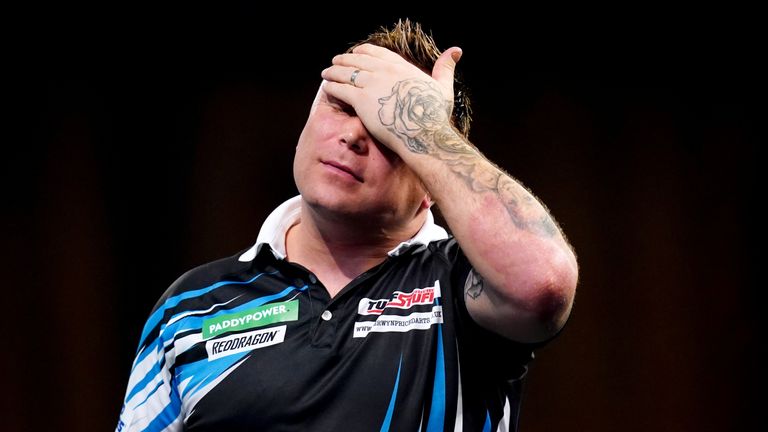A PDC spokesperson said: “Gerwyn decided not to complete his match against Brendan Dolan and left the venue immediately. We understand he felt the venue was cold”; Luke Littler wins the Wigan tournament on his Players Championship debut, throwing a nine-darter in his third-round match

Image: Gerwyn Price criticised the tournament on social media after withdrawing during his last-32 match against Brendan Dolan
Former world darts champion Gerwyn Price withdrew halfway through a third-round match at the Players Championship in Wigan after what he claimed were “absolutely pathetic conditions”.
Price was trailing 4-2 on legs against Brendan Dolan in a best-of-11-legs encounter when he forfeited the match at Robin Park Tennis Centre, with Dolan handed a bye into the next round.
The Welshman later wrote on Instagram: “Absolutely pathetic conditions, travel all the way to Wigan to play in a professional game and we have to play in less than amateur conditions.
- Luke Littler fires nine-darter as he wins on Players Championship debut
- Premier League Darts: Ultimate guide to the 2024 line-up
- Stream the biggest moments on NOW | Get Sky Sports
“Never have [I] ever given a game up, well that’s me out tomorrow as well. Gutted because my game was really good today and I rely on these events so much.”
Price did not elaborate on why he felt the playing conditions were so poor. The second Players Championship event takes place at the same venue on Tuesday.
A spokesperson for the Professional Darts Corporation (PDC) told Sky Sports: “Gerwyn decided not to complete his match against Brendan Dolan and left the venue immediately. We understand he felt the venue was cold.”
Prior to his withdrawal, Price had come through a final-leg decider against Karel Sedlacek and then saw off Matthew Dennant with a 111 average to reach the last 32.
Littler fires nine-darter on Players Championship debut

Image: Luke Littler fired a nine-darter in the Players Championship 01 event in Wigan
Teenage sensation Luke Littler emerged victorious at the event, on his Players Championship debut, hitting a nine-dart finish along the way when beating Michele Turetta in the third round.
The 17-year-old superstar continued his run by beating Cameron Menzies 6-2 in the next round, very nearly taking out a second nine-darter in as many matches in the process.

Luke Littler was agonisingly close to hitting his second nine-darter of the night on his Players Championship debut in Wigan
Littler then breezed past James Hurrell 6-3 in the quarter-finals, before edging thrilling final-leg deciders against both Alan Soutar in the semi-finals and Ryan Searle in the final, where he emerged victorious with a superb 110 average.
Littler became a household name during a shock run to the final of the World Championship at the turn of the year, going on to beat Michael van Gerwen to win the Bahrain Masters in January, becoming the youngest player to hit a televised nine-darter in his quarter-final victory over Nathan Aspinall.
Littler’s strong form continued as he was beaten by home favourite Van Gerwen in the final of the Dutch Masters the following week.
Luke Humphries, who beat Littler to claim his first World Championship crown, was the victim of a shock defeat in Wigan as the second seed crashed out 6-0 to Ian White in round two.
Get Sky Sports on WhatsApp!
You can now start receiving messages and alerts for the latest breaking sports news, analysis, in-depth features and videos from our dedicated WhatsApp channel!

Find out more here…
Premier League Darts continues on Sky Sports on Thursday February 15 as Glasgow is the next stop on the 17-week extravaganza all the way through to the Play-Offs at the O2 Arena in London on Thursday, May 23. Stream Sky Sports Darts without a contract through NOW
Sourse: skysports.com